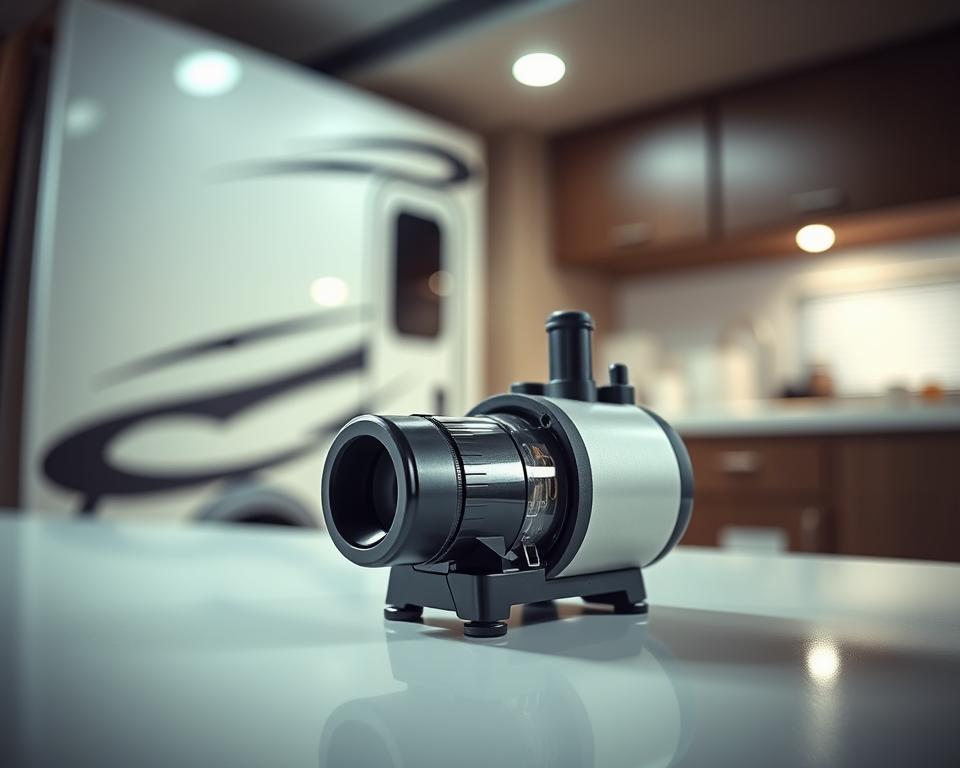Your RV Black Water Tank Pump: Guide and Maintenance Tips
The functionality of your RV black water tank pump is crucial for your travels, have you ever wondered about it? It is a fundamental part of your RV’s waste disposal system. Proper maintenance is crucial for seamless travels. This guide provides essential details for handling your RV waste water pump. Knowing how vital it is will help you boost its efficiency and further enjoy your RV travels.
Highlight Reel
- A key component for managing waste effectively is the RV black water tank pump.
- Regular maintenance can prolong the lifespan of your RV waste water pump.
- Knowing about the different parts of the system improves your ability to troubleshoot.
- It’s crucial to follow safe dumping procedures for hygiene and environmental reasons.
- Proper winterization of your RV black water tank system can save you money on repairs.
- A clean RV sanitation pump helps prevent blockages and bad smells.
Understanding RV Water Tanks
Perhaps many RV owners haven’t fully understood the importance of having different water tanks for a seamless camping experience with RV septic pumping. It’s essential to know what the RV fresh water, gray water, and black water tanks do. Each plays a unique role and needs proper care.
Drinkable water is stored in the RV fresh water tank. This water is for drinking, cooking, and staying clean. Maintaining the cleanliness of this tank and the safety of its water is crucial. Fresh water is crucial for hydration and health during travels.
Conversely, the RV gray water tank gathers used water from sinks and showers. Due to its capacity to fill quickly, this tank requires regular checks and emptying. For a clean living space in your RV, you must manage the gray water tank appropriately.
As it holds toilet waste, the RV black water tank is of utmost importance. Preventing odors and buildup necessitates constant monitoring of this tank. Applying the proper tank chemicals will improve the tank’s condition and your RVing experience. Knowing how to care for each tank makes RV trips more enjoyable.
What is the RV Black Water Tank Pump?
A key component of recreational vehicle sanitation is the RV black water tank pump. Waste is transported by this pump to designated places for disposal. Understanding its operation is crucial for proper maintenance and preventing costly repairs.
There are different types of pumps available for RV owners, such as the sewer pump. The macerator pump is a favorite because it grinds waste, making disposal faster. It’s especially convenient when there are many people at the dump stations.
It’s vital to have a high-quality RV black tank pump for proper waste management. This helps maintain cleanliness and comfort in the RV. By regularly checking and knowing how your pump works, you can improve your RV experience.
Knowing the Different Parts of the Black Water Tank System
The RV black water tank system must be understood for proper waste management. It involves numerous vital components that work together to ensure smooth functionality. Holding the waste from the RV’s toilet, the black water tank is the most important part. Designed to last through different conditions, it’s made of robust materials.

Transferring waste to a specific dump station, the system’s pump is very important. It’s a must-have for anyone with an RV. Sewer hoses also play a key part, offering a flexible connection between the tank and dump station. By preventing leaks and containing odors, these hoses ensure a clean waste disposal process.
For the attachment of sewer hoses, which enables effective waste transfer, connection ports are essential. For the management of waste flow, termination valves are essential. These valves ensure sanitation by preventing backflow and spills during the disposal process.
By becoming familiar with these vital components, RV owners can maintain their sanitation system effectively. Knowing this is crucial for fixing problems while traveling or using the RV, which improves the whole RV experience.
Best Practices for Using Your RV Black Water Tank Pump
Becoming proficient in using the RV sanitation pump significantly enhances your RV lifestyle. It’s vital to understand the correct way to operate the black tank for a system that functions smoothly. A crucial step is to make sure you flush the tank well after each use. By doing this, you prevent solid waste from accumulating, which could cause blockages and other difficulties.
Ensuring your RV sanitation pump functions as expected requires regular checks. Taking this action beforehand can help you avoid any unpleasant occurrences while traveling. It is also essential to use toilet paper made specifically for RVs. Designed to disintegrate quickly, this type of toilet paper helps in reducing the risk of clogs.
Another important thing to do is to keep the termination valves closed, except when you’re emptying the tank. This will help keep the smells away. Adding tank deodorants and cleaners will also contribute to a pleasant smell and cleanliness in the system. Adhering to these guidelines enhances your experience with the RV black water tank.
| Guidelines for Using Your Black Tank Correctly | Advantages |
|---|---|
| Make Sure to Flush with Enough Water | Prevents solid waste clogs |
| Perform Routine Checks on Pump Operation | Guarantees it’s working properly |
| Ensure You’re Using RV Toilet Paper | Reduces risk of blockages |
| It’s Important to Keep the Termination Valves Closed | Helps keep odors down |
| Add Tank Deodorants and Cleaning Agents | Ensures the system remains hygienic and without odors |
Important Maintenance Tips for the Black Water Tank Pump
Regular maintenance is essential to make sure your RV’s black water tank pump lasts and works well. Part of this is using the appropriate chemical treatments that are specifically formulated for these tanks. Waste is broken down efficiently by them, and they also prevent odors.
It’s also critical to ensure enough water flows during toilet use. This ensures that waste goes smoothly into the tank, which helps to minimize the risk of buildup. Don’t forget to also regularly perform a deep clean of the tank and its components. For this important job, use the tools that are recommended.
Keep an eye on the tank levels at all times to prevent problems. Address leaks or overflows without delay. To stop solid waste from building up, be sure to empty the tank regularly. A maintenance schedule can help you avoid problems with your RV experience.
| Maintenance Task | Periodicity | Information |
|---|---|---|
| Check levels | Each and every trip | Check that the tank isn’t filled beyond capacity to prevent leaks. |
| Add chemical treatment | After each dump | Add treatments to break down waste effectively. |
| Flush system | On a monthly basis | Make sure to use a cleaning solution to keep the tank clean. |
| Check the pump | Prior to extended travel | Make sure there’s no wear and tear to prevent the pump from breaking down while you’re traveling. |
| Clear out the tank | When required | Empty the tank when full, ideally at designated dump stations. |
These key maintenance practices will help your black water tank pump function effectively. This will improve your RV trips significantly.
Troubleshooting Common Problems with Your Black Water Tank Pump
Addressing issues with the black tank pump might seem intimidating. Many people who own RVs run into various issues with their RV black tanks, such as blockages, leaks, or ongoing bad smells. Knowing how to address these challenges early can save time and costly repairs.
First, you should inspect the hoses that are connected to the black tank pump. Often, blockages form in these hoses, making the pump less effective. Take the hoses off and see if there’s any buildup or dirt inside. If you find any blockages, make sure to clean the hoses completely before putting them back on.
Next, asses the seals around the pump and the tank. If the seals are damaged, it can cause leaks that you might not notice until a lot of damage has been done. Replace any faulty seals immediately to prevent further issues.
If you’re dealing with odors that just won’t disappear, enzyme treatments might be useful. These treatments help to dissolve waste and get rid of bad smells. Ensure you follow the instructions provided by the manufacturer to get the best results.
Here is a quick reference table summarizing common issues and their solutions:
| Problem | Likely Cause | What to Do |
|---|---|---|
| Build-up | Dirt or waste in the hoses or tank | Look at and clean the hoses |
| Loss of liquid | Damaged seals | Examine the seals and replace any faulty ones |
| Bad smells | Waste buildup | Apply enzyme treatments |
| Pump not working | Electrical issues | Inspect the connections and battery |
Spotting the initial signs of trouble can prevent minor issues from escalating into serious RV black tank problems. Regular maintenance and vigilance will enhance the longevity of your black tank pump, improving your RV experience.
How to Clean Your RV Black Water Tank Pump
Keeping your RV’s black water tank clean is essential for hygiene and its plumbing system. Make it a goal to rinse with fresh water after each use to minimize odors and ensure smooth operation. By doing this, you reduce the accumulation of waste and help maintain the tank’s condition.
For a deeper clean, use cleaning solutions made for black water systems. These products are good at dissolving waste and fighting bad smells. Pour water and the cleaning solution into the tank, and allow it to soak. The job of cleaning is made easier if your RV has a built-in flush system.
Driving with sharp turns or using sloshing techniques can help to stir up the contents of the tank. It assists in loosening any residue that may be clinging to the inside of the tank. Cleaning in this way helps the sensors be more accurate, which can help you avoid sewage problems.
Safe Dumping Practices at Dump Stations
Knowing how to act properly at RV dump stations is crucial for maintaining a pleasant environment for everyone. When you arrive at the station, ensure your RV is placed correctly. Then, get your gear ready for dumping.
To make sure the process goes smoothly, follow these steps closely:
- Ensure a firm connection between your sewer hose and the station’s outlet.
- The first step is to open the black water valve so the sewage can flow out.
- When the black tank has finished emptying, close its valve. Then, open the gray water valve to clean the hose with the less dirty water.
- When you’re done, carefully take off your hose to avoid any spills.
- Always use safe drinking water to clean your hoses and then store them immediately.
Another crucial thing is to follow the local rules for disposing of waste. To protect the environment, many areas have rules that you are required to follow. Not following these can result in fines or other consequences.
Respectful behavior at RV dump stations contributes to a better experience for all users. By keeping the area tidy and sticking to the rules, you show care for the community. These kinds of actions help to build a culture of responsibility among RV lovers and encourage camping habits that are environmentally friendly.
Winter Preparation for Your RV Black Water Tank System
Winterizing your RV tanks is essential to keep the black water system safe from freezing. To avoid damage from water freezing within the system, it’s important to prepare correctly. Following a set of specific steps will ensure that your RV black tank receives effective winter care.
- Begin by completely emptying the black water tank using the correct pump and connections.
- After that, bypass the water heater so that water doesn’t get into it and build up.
- Make sure to use antifreeze that is made for RVs, because regular antifreeze can be poisonous and bad for the environment. Pour the antifreeze into the system according to the product instructions.
- Leave all faucets and drains open to allow any remaining water to escape and for the antifreeze to circulate properly.
- Finally, check that all access panels are sealed and secure to prevent water intrusion during winter months.
These winterization steps help RV owners protect their black water tank systems from the damaging effects of winter. This forward-thinking helps avoid expensive repairs or maintenance when the season changes.
The Final Word
To be a successful RV owner, you really need to maintain your RV black water tank efficiently. By mastering the black water tank pump and adhering to the upkeep strategies in this guide, your travel becomes more enjoyable. If you take proper care of your gear, it will last longer and managing RV waste will be simpler. This makes travel less daunting.
Knowing about your RV’s black water system is essential for dealing with problems directly. Adopting maintenance, troubleshooting, and cleaning methods prevents unexpected malfunctions. This lets you enjoy worry-free road trips. Getting help from trusted services like All in Sanitation can support your maintenance efforts. They give you the important products and support you need for great care.
Attentiveness and proper care for every part of your RV, including the black water tank, are part of being a good RV owner. With this knowledge, you’re prepared to explore freely. By doing all the right things, you’ve ensured a fantastic trip for yourself and others.


